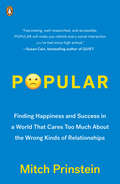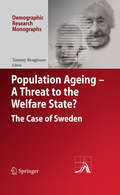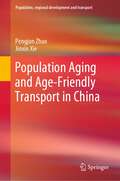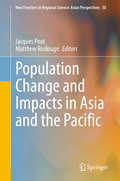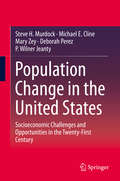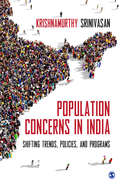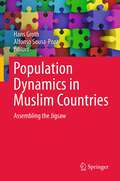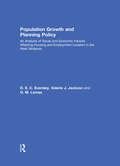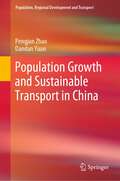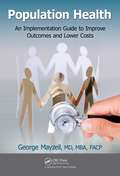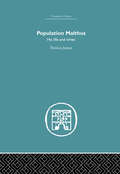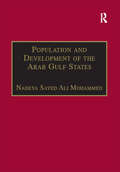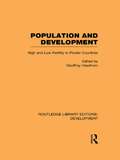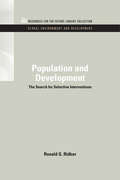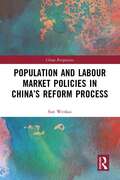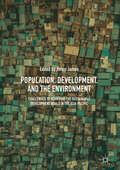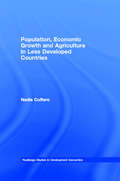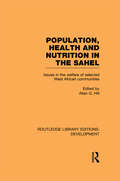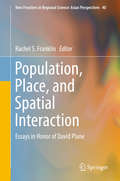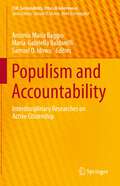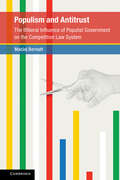- Table View
- List View
Popular Support for an Undemocratic Regime
by Neil Munro Richard Rose William MishlerTo survive, all forms of government require popular support, whether voluntary or involuntary. Following the collapse of the Soviet system, Russia's rulers took steps toward democracy, yet under Vladimir Putin Russia has become increasingly undemocratic. This book uses a unique source of evidence, eighteen surveys of Russian public opinion from the first month of the new regime in 1992 up to 2009, to track the changing views of Russians. Clearly presented and sophisticated figures and tables show how political support has increased because of a sense of resignation that is even stronger than the unstable benefits of exporting oil and gas. Whilst comparative analyses of surveys on other continents show that Russia's elite is not alone in being able to mobilize popular support for an undemocratic regime, Russia provides an outstanding caution that popular support can grow when governors reject democracy and create an undemocratic regime.
Popular: Finding Happiness and Success in a World That Cares Too Much About the Wrong Kinds of Relationships
by Mitch PrinsteinA leading psychologist examines how our popularity affects our success, our relationships, and our happiness—and why we don’t always want to be the most popularNo matter how old you are, there’s a good chance that the word “popular” immediately transports you back to your teenage years. Most of us can easily recall the adolescent social cliques, the high school pecking order, and which of our peers stood out as the most or the least popular teens we knew. Even as adults we all still remember exactly where we stood in the high school social hierarchy, and the powerful emotions associated with our status persist decades later. This may be for good reason. Popular examines why popularity plays such a key role in our development and, ultimately, how it still influences our happiness and success today. In many ways—some even beyond our conscious awareness—those old dynamics of our youth continue to play out in every business meeting, every social gathering, in our personal relationships, and even how we raise our children. Our popularity even affects our DNA, our health, and our mortality in fascinating ways we never previously realized. More than childhood intelligence, family background, or prior psychological issues, research indicates that it’s how popular we were in our early years that predicts how successful and how happy we grow up to be. But it’s not always the conventionally popular people who fare the best, for the simple reason that there is more than one type of popularity—and many of us still long for the wrong one. As children, we strive to be likable, which can offer real benefits not only on the playground but throughout our lives. In adolescence, though, a new form of popularity emerges, and we suddenly begin to care about status, power, influence, and notoriety—research indicates that this type of popularity hurts us more than we realize. Realistically, we can’t ignore our natural human social impulses to be included and well-regarded by others, but we can learn how to manage those impulses in beneficial and gratifying ways. Popular relies on the latest research in psychology and neuroscience to help us make the wisest choices for ourselves and for our children, so we may all pursue more meaningful, satisfying, and rewarding relationships.
Population Ageing - A Threat to the Welfare State?: The Case of Sweden
by Tommy BengtssonThis book is the first to take a comprehensive view of the challenges that population ageing present in the near future taking Sweden as the case. Can the increasing number of retirees per worker be stopped by immigration or increasing fertility or will we need to increase pension age instead? Cost for the social-care system is readily increasing; even more is the costs for health care. Can the galloping costs be funded by an increase in taxes or do we need to make reforms, similar to the ones already made in the pension system, which has been used as a model for many other countries. The fact that it is difficult to make health care dependent on personal contributions, as is the case of the pension system, funding of health care is a true test of solidarity across generations. The book ends with a discussion on whether the demographic challenge to the welfare system is also a threat to the welfare state as such.
Population Aging and Age-Friendly Transport in China (Population, Regional Development and Transport)
by Pengjun Zhao Jinxin XieThis book is the first book that investigates aging and its impacts on transport system in China. Using various data, this book covers, but is not limited to, the development of population aging, the changes of travel demand, the features of travel behavior of China’s elderly, progress and prospect of age-friendly transport in China. The book has international academic novelty in three points. Firstly, it discovers the long-term supply-demand relationship between population aging and transport infrastructure development. Secondly, it finds the changes and factors in travel behavior of the elderly people. Thirdly, it discusses the advantages or disadvantages of age-friendly transport policy. The findings in the book provide fresh evidences for the challenges posed by aging to transport and enhance readers’ existing knowledge of the elderly people’s travel behavior and the related determinants. These findings are helpful for planners and politicians to make age-friendly transport policies and useful for investors and enterprises to supply proper transport services to the elderly people. This book is of great interest to scholars and practitioners interested in transport development, transport policy, social transition, sustainable mobility, urban planning, urban governance and is relevant to China and other developing countries.
Population Change and Impacts in Asia and the Pacific (New Frontiers in Regional Science: Asian Perspectives #30)
by Jacques Poot Matthew RoskrugeThis volume brings together a range of contributions that provide contemporary regional science perspectives on population change and its socio-economic consequences in the Asia-Pacific region. This region accounts for close to two-thirds of the world’s population and is highly diverse in terms of key demographic indicators such as population size, growth, composition and distribution. The authors provide quantitative assessments, either descriptively or by means of modelling, of important demographic issues affecting this part of the world.The topics addressed include: broad demographic trends across the Asia-Pacific region and its sub-regions; assessment of population decline, urbanization and spatial distribution using cases from China, Colombia, Japan and Australia; migration and economic impacts in Australasia, Chile and Timor Leste; and the impacts of declining or low fertility and population ageing in China, India, Thailand, and across Asia.Given its scope, the book will appeal to all readers seeking to understand population change and impacts across the Asia-Pacific region, with a specific focus on sub-regional differences and dynamics.
Population Change in the United States
by Steve H. Murdock Michael E. Cline Mary Zey Deborah Perez P. Wilner JeantyThis new volume maps the complex interplay of demographic and socioeconomic changes in the United States, where rapid aging and ethnic diversification are merely the most salient of the many issues with major long-term implications. Drawing on The United States Census Bureau's post-2010 detailed projections, as well as a wealth of data distilled from authoritative sources, the authors tackle many of the urgent policy questions raised by America's changing population. The book explores the ways economic markets are adapting to an older and more diverse customer base, how the projected demographic change will impact public service demand, the growing economic disparities between asset-rich baby boomers and youth struggling for economic security, and how the projected demographic patterns will change the fiscal, economic, education, health, and housing sectors and alter the social structures and processes impacting American households and the diverse array of America's future population. A thorough survey of major demographic patterns in the USA up to 2050 is followed by an assessment of how these will affect socioeconomic, public service, fiscal, economic, and social structures and mechanisms, down to the size and composition of households. The analysis then considers possible variations of outcome predicated on alternative dynamic patterns between demographics and socioeconomics. Cutting through the politics and communal anxieties with hard, cutting-edge data, this study will be a primary source for all those who must use its contents to guide their decisions.
Population Concerns in India: Shifting Trends, Policies, and Programs
by Professor Krishnamurthy SrinivasanA major concern for any country’s polity and development, the issue of population has always been particularly problematic in India given the diversity of religions and other social stratifications. Population Concerns in India: Shifting Trends, Policies, and Programs analyzes how the country has handled this concern in the seven decades post Independence. The book discusses the various policies and programs that were considered most appropriate in different situations, and deliberates over how the population problem was perceived at different times. It also highlights the results achieved by India’s Family Planning Programme and the implications of the successful experiences. Written by an internationally renowned demographer, this book recommends policies that can effectively deal with the population concerns in this country.
Population Dynamics in Muslim Countries
by Alfonso Sousa-Poza Hans GrothThe book discusses the demographic changes in Muslim countries. It thereby focuses on topics such as the demographic dividend and the demographic transition, labour market challenges, health care, universal education and gender issues. These challenges are addressed at a country level and include policy implications for the large majority of the Muslim countries covered in this book. Moreover, political consequences for Europe with respect to the integration of Muslims are presented to the reader.
Population Growth and Planning Policy: Housing and Employment Location in the West Midlands
by D. E. Eversley V. Jackson G. LomasFirst Published in 1965. Routledge is an imprint of Taylor & Francis, an informa company.
Population Growth and Sustainable Transport in China (Population, Regional Development and Transport)
by Pengjun Zhao Dandan YuanThis book discusses the links between population growth, migration and the transport system in China. It first reviews the theories concerning the relationship between population growth, distribution and transport systems from an international perspective and then analyses the history of and changes in population growth, population migration, urbanisation and population spatial distribution in China by using multiple data sources, including the census, China Family Panel Studies data, China Migrants Panel Studies data and mobile phone data. Thirdly, it explores the effects of population growth and migration on transport infrastructures and services in terms of planning, investments, development, operation and management. The book also evaluates the features, strengths and weaknesses of various population policies on the basis of their impacts on transport, birth control, the hukou system, the migration management system and the policies designed to limit the growth of large cities and encourage the growth of small cities. Further, it addresses transport policies in the context of their capacity to meet people’s mobility and accessibility needs and other factors, including energy consumption, environment pollution and regional development inequalities. Examining the trends in population distribution and their influences on transport, such as an increase in urban agglomeration and mega city regions in the east of China and population shrinkage in the cities and regions in northeast and west China, it also investigates the new trends of rural migration and population movement during the Spring Festival and other public holidays and the challenges of these new trends for transport system. Lastly, the book discusses future directions and challenges, sustainable population and transport policies and proposes population-oriented transport strategies and accessibility-based population distribution policies. Relevant to China and other developing countries, the book is a valuable resource for scholars interested in population studies, sustainable transportation, regional planning and development and environmental policy.
Population Health: An Implementation Guide to Improve Outcomes and Lower Costs
by MD, MBA, MayzellAs healthcare moves from volume to value, payment models and delivery systems will need to change their focus from the individual patient to a population orientation. This will move our economic model from that of a "sick system" to a system of care focused on prevention, boosting patient engagement, and reducing medical expenditures. This new focu
Population Malthus: His Life and Times
by Patricia JamesThis is a fascinating insight into the work of one of our greatest thinkers. Thomas Robert Malthus (1766–1834) is best remembered today for his theories on the menace of over-population; this first ever full-length biography shows him also in his role as one of the founders of classical political economy, still a controversial figure in the history of economic thought. Based on exhaustive research among contemporary sources, it gives an account of Malthus’s two careers, as an economist and as a professor at the East India College. Patricia James describes how, at the East India College, Malthus was influential in the establishment of an incorruptible Civil Service and the modern system of written examinations, in circumstances which seem almost farcical today. She gives an account of his family and social life, which was full of warmth and variety, with an abundance of ‘characters’ as well as many famous men. People nowadays are inclined to argue in a vacuum whether Malthus is ‘right’ or ‘wrong’ about population outrunning subsistence, and about the adequacy of aggregate demand in a capitalist society. Patricia James shows him in his historical setting, so that the book is a study both of the man and of the age in which he lived. She believes that, paradoxically, if we view Malthus’s works as the period pieces they are, it becomes more and not less easy to see their relevance to our own problems. Although Malthus’s search for basic principles in a changing world was confused and erratic, his ideas are still illuminating to those who prefer investigation and reappraisal to the mere reiteration of dogma. This text was first published in 1975.
Population Services International: The Social Marketing Project in Bangladesh
by V. Kasturi RanganPopulation Services International (PSI) was a not-for-profit agency founded to disseminate family planning information and to market birth control products, primarily in less developed countries seeking to curb their population explosions. In 1976, PSI concluded an agreement with the government of Bangladesh to conduct a social marketing program, with the objective of using modern marketing techniques to sell subsidized contraceptives through commercial outlets. Seven years later, three PSI managers were meeting at PSI's Washington, D.C. headquarters to discuss 1984-86 marketing strategy for two products: Raja condoms and Maya birth control pills. Of particular concern was the fact that the marketing approach that had proven extremely successful for Raja was yielding poor sales results for Maya. The PSI managers needed to devise an action plan for improving Maya Sales.
Population Services International: The Social Marketing Project in Bangladesh (Abridged)
by James E. AustinPopulation Services International (PSI) was a not-for-profit agency founded to disseminate family planning information and to market birth control products, primarily in less developed countries seeking to curb their population explosions. In 1976, PSI concluded an agreement with the government of Bangladesh to conduct a social marketing program, with the objective of using modern marketing techniques to sell subsidized contraceptives through commercial outlets. Seven years later, three PSI managers were meeting at PSI's Washington, D.C. headquarters to discuss 1984-86 marketing strategy for two products: Raja condoms and Maya birth control pills. Of particular concern was the fact that the marketing approach that had proven extremely successful for Raja was yielding poor sales results for Maya. The PSI managers needed to devise an action plan for improving Maya sales.
Population Trends in New Jersey
by David Listokin James W. HughesTo fully understand New Jersey in the 2020s and beyond, it is crucial to understand its ever-changing population. This book examines the twenty-first century demographic trends that are reshaping the state now and will continue to do so in the future. But trend analysis requires a deep historical context. Present-day New Jersey is the result of a long demographic and economic journey that has taken place over centuries, constantly influenced by national and global forces. This book provides a detailed examination of this journey. The result is present-day New Jersey. The authors also highlight key trends that will continue to transform the state: domestic migration out of the state and immigration into it; increasing diversity; slower overall population growth; contracting fertility; the household revolution and changing living arrangements; generational disruptions; and suburbanization versus re-urbanization. All of these factors help place in context the result of the 2020 decennial U.S. Census. While the book focuses on New Jersey, the Garden State is a template of demographic, economic, social, and other forces characterizing the United States in the twenty-first century.
Population and Development of the Arab Gulf States: The Case of Bahrain, Oman and Kuwait
by Nadeya Sayed MohammedThis thought-provoking study measures and critically examines the effects that an average population growth rate of 2.8% could have on the development of the Arab Gulf States. It questions the ability of Gulf governments to continue providing relatively high standards of education, health and employment under conditions of rapid population growth, an undiversified economic base, and a tribal political framework.  Within this context, population growth is identified as one important variable that hinders long-term development. The book will appeal to all those interested in the Middle East, demography, development and sociology.
Population and Development: High and Low Fertility in Poorer Countries (Routledge Library Editions: Development)
by Geoffrey HawthornFirst published in 1978, this book explores the vital global issue of high and low fertility in poorer countries through a series of case studies by contemporary experts in the fields of development and demography. These studies examine such issues as: the relations between fertility rates and income distributions in poor societies; the question of whether or not neo-classical macro-economics are sufficient to understand and to try to engineer relations between economies and populations; and the specifics of the relations between fertility and a variety of socio-economic factors in both South Asia and West Africa. The point of the collection is to explain how very far general models can be taken, and to suggest that they cannot be taken as far as those who have tended to ignore the structural complexities of, and differences between, various societies have implied.
Population and Development: The Search for Selective Interventions (RFF Global Environment and Development Set)
by Ronald G. RidkerFirst Published in 2011. This book grew out of a project initiated by Resources for the Future to search for selective interventions into the development process that in turn might speed the course of fertility decline in developing countries. The result is a volume the authors hope will find wide use, not only by researchers and serious students of population problems, but also by administrators and policy makers.
Population and Labour Market Policies in China’s Reform Process (China Perspectives)
by Sun WenkaiThis book investigates the population and labour management reforms implemented since the reform and opening up of China in the early 1980s, giving insights into the economic and social implications of these reforms and future prospects for population governance. The study examines three major components of China’s population management strategy in terms of its history and implementation: the household registration (Hukou) system, family planning policy, and the labour market system. Grounded in both qualitative and quantitative analysis, key metrics are introduced to better understand the Hukou system on the one hand while exploring the socio-economic issues arising from the policy, including the economic behaviour or residents, fertility, care of older people, entrepreneurship, institutional premiums and gender wage differentials. Based on these investigations, the author advances constructive suggestions to inform policymaking, aiming to deepen market-oriented reform of the economic system and improve social welfare in China.The title will be a good reference for academics, students and policy makers interested in social policy, labour economics and especially China’s population and labour policy and Chinese economy and society.
Population, Development, and the Environment: Challenges to Achieving the Sustainable Development Goals in the Asia Pacific
by Helen JamesThis book takes the reader into some of the most intransigent social, economic, and political issues that impact achieving sustainable development in Asia and the Pacific. Through meticulous analysis of the integrated relationships between population, development, and the environment, the chapters in this volume investigate the impacts of hydropower development on fragile ecosystems; mining, landslides and environmental degradation; deforestation; water and food security; rural-urban migration, poverty alleviation, civil society and community empowerment; and how disaster recovery requires multi-scalar and multi-disciplinary approaches that take into account governance, culture, and leadership. Legal frameworks may be legislated, but are often rarely implemented.The book will be valuable to students of sustainability, population and development, and governmental policy advising sectors as well as the NGO and humanitarian sectors. The distinctive characteristic of this book is that it encapsulates an integrated, multi-disciplinary focus which brings to the discussion both robust empirical research and challenging policy applications in the investigation of how the sustainable development goals may be achieved in Asia and the Pacific.
Population, Economic Growth and Agriculture in Less Developed Countries (Routledge Studies in Development Economics #Vol. 23)
by Nadia CuffaroIn 1950 the world population was 2.5 billion; fifty years later there are over 6 billion people. The demographic of this explosion has essentially occurred in the developing areas of the world. The key to understanding many contemporary development problems that have arisen from this rapid growth is in understanding the relationships between population and the economy.This book offers an analysis of such relationships, encompassing a review of the major positions in the academic debate.Population, Economic Growth and Agriculture in Less Developed Countries will serve as a useful introduction and reference tool for students, academics and all with an interest in the population debate and economics.
Population, Health and Nutrition in the Sahel: Issues in the Welfare of Selected West African Communities (Routledge Library Editions: Development)
by Allan G. HillThis collection of studies, first published in 1985, describes some contemporary problems of selected pastoral and agro-pastoral communities of the West African Sahel. Several important features of the Sahel are illustrated: the significance of seasonal factors in causing periodic stress amongst people and animals, the economic uncertainty introduced by interannual climactic variations, as well as the role of traditional systems of social and economic organisation in providing some support during periods of need. The findings presented here are published in co-operation with the Sahel Institute, a regional research organisation set up in the early 1970s with representation from eight Sahelian countries – Cape Verde, Chad, Gambia, Mali, Mauritania, Niger, Senegal and Upper Volta.
Population, Place, and Spatial Interaction: Essays in Honor of David Plane (New Frontiers in Regional Science: Asian Perspectives #40)
by Rachel S. FranklinThis volume is devoted to the geographical—or spatial—aspects of population research in regional science, spanning spatial demographic methods for population composition and migration to studies of internal and international migration to investigations of the role of population in related fields such as climate change and economic growth. If spatial aspects of economic growth and development are the flagship of the regional science discipline, population research is the anchor. People migrate, consume, produce, and demand services. People are the source and beneficiaries of national, regional, and local growth and development. Since the origins of regional science, demographic research has been at the core of the discipline. Contributions in this volume are both retrospective and prospective, offering in their ensemble an authoritative overview of demographic research within the field of regional science.
Populism and Accountability: Interdisciplinary Researches on Active Citizenship (CSR, Sustainability, Ethics & Governance)
by Samuel O. Idowu Maria-Gabriella Baldarelli Antonio Maria BaggioThis book takes into consideration the development of different forms of populism in various countries with democratic political systems over the past two decades. Despite the diversity existing between current populisms, common elements have emerged: the tendency to diminish the role of political representation, the centrality of the "charismatic leader," the nationalistic idealization of "people" that undermine international agreements. How do these phenomena affect the instruments, rules, and culture of democracy? Why does populism receive strong acclaim? How can leaders respond to the real needs that can be at the basis of populisms without abandoning democratic principles? Using an interdisciplinary approach which emphasizes accountability and responsibility, this book addresses these and other issues facing current and future corporate leaders. The chapters offer suggestions on how to choose between major worthy causes, how to effectively measure the outcomes of social responsible action, and how to navigate the challenges of accountability. Providing practical tools to combat the root of populism in business and community, this book is intended for practitioners, researchers, and students of business and management, politics, and other related disciplines such as public administration, social science, and the humanities.
Populism and Antitrust: The Illiberal Influence of Populist Government on the Competition Law System (Global Competition Law and Economics Policy)
by Maciej BernattCompetition law is designed to promote a consumer-friendly economy, but for the law to work in practice, competition agencies - and the courts who oversee them - must enforce it effectively and impartially. Today, however, the rule of populist governments is challenging the foundations of competition law in unprecedented ways. In this comprehensive work, Maciej Bernatt analyses these challenges and describes how populist governments have influenced national and regional (EU) competition law systems. Using empirical findings from Poland and Hungary, Bernatt proposes a new theoretical framework that will allow the illiberal influence of populism on competition law systems to be better measured and understood. Populism and Antitrust will be of interest not only to antitrust and constitutional law scholars, but also to those concerned about the future of liberal democracy and free markets.

